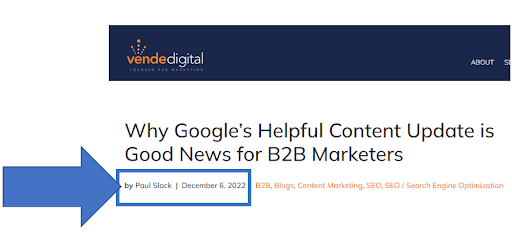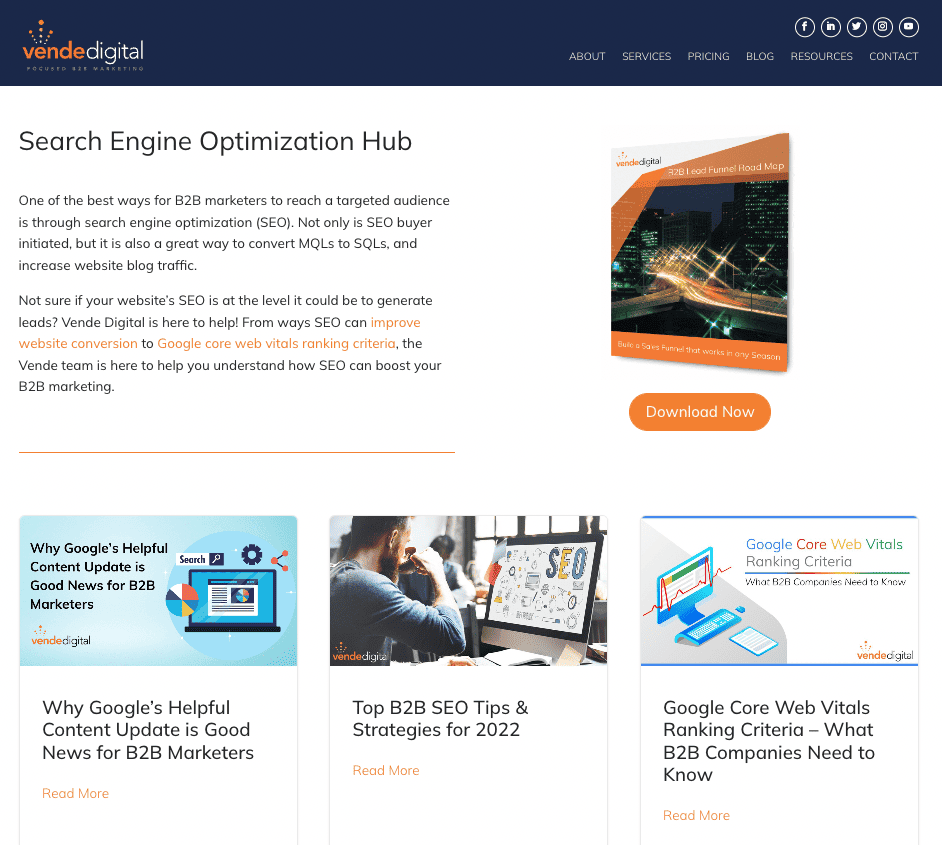
Top Google SEO Ranking Factors for B2B Companies in 2023
Everyone wants to be number one in Google search results. It's the prize every B2B company wants to attain. The problem is that many factors affect whether you will rank well in Google. And many B2B marketers find themselves overwhelmed by the task.
This article shares the fundamentals of B2B search engine optimization (SEO) and how to get your website to rank better in Google’s search results, including B2B SEO ranking factors for 2023. On a side note, if it looks like your search traffic has gone down, it may be due to the transition from Google Universal Analytics to GA4.
Is SEO Important for B2B Companies?
SEO is essential for B2B companies to increase their online visibility, reach more qualified leads, and drive more sales. Following SEO best practices will make your website content rank well for terms customers use when looking for information about what you do or sell.
6 B2B SEO Ranking Factors for 2023
When approaching your SEO strategy for 2023, there is much more to it than just picking keywords or phrases; you need to think about all six fundamental components working together.
Let's take a look at each one.
Website Architecture & Technical SEO
You want to ensure that Google can easily crawl (scan) all the pages of your site. But most websites make it difficult for Google to establish what their content is about, making it harder for Google to rank it.
Think of it this way, if Google can’t crawl your site, your content is invisible to them. Google also cares a lot about user experience. If your site doesn’t perform well and is hard to crawl, they will assume it isn’t very beneficial to humans. Here are key factors we’ve found make the most significant difference:
- Slow load times
- Responsive/mobile-friendliness
- Code Bloat
- Missing XML site map
- Unsecure site (missing SSL certificate)
- Unoptimized images
- Broken links
- Missing images
Ensuring your site is architecturally sound is as important as the content itself. You can use our website analyzer to identify any technical issues that keep your website from ranking well.
On-Page SEO
On-page SEO is one of the places where your keywords are important. Each page of your website needs to tell Google about the content on that page, known as on-page SEO.
Think of the search engine algorithm as a detective. It’s constantly looking for clues. And the more clues you drop on your pages, the better Google will understand the content.
You can add clues (keywords) in places like:
- Title Tags
- The first sentence in the first paragraph
- Page headlines & subheads
- Metadata
- Categories and Tags used for blog content
- Semantic markup
Dropping clues in these places will translate into ranking higher for the critical search terms, which leads to more traffic.
Web Page URL
Believe it or not, what you have in your URL matters. Google looks at each page’s URL for clues to help Google better understand the content of the page.
Many websites run on WordPress, which automatically creates a URL from the page title. This automation can lead to having a ridiculously long URL. You’ll want to shorten the URL to the least amount of words possible and ensure it includes the primary key phase.
Also, take a look at your website’s primary pages of your website and ensure the page URL is descriptive enough.
For example, does your Services page URL look like this:
www.YourWebsite.com/Service
It would be much better if the URL were:
www.YourWebsite.com/B2B_Demand_Gen_Services (Vende keywords added for emphasis)
Links
Two kinds of links are important ranking factors for SEO, Internal and External. One overlooked aspect of website architecture is internal links, which can negatively affect Google’s ability to map out your website. This is because web crawlers are designed to follow links to index your web pages.
The more internal links, the better. Think about how content on your site relates to other content.
For example:
If Page A references a topic covered on Page B, create an internal link.
This will provide a good user experience and indicate to Google that there is a hierarchy and flow of content, which will play in your favor.
Have you ever wondered why Wikipedia shows up near the top of almost every search result and how their content is full of links to other content? This is the same concept.
External or backlinks from other reputable websites can help improve your search engine rankings. They are clues search engines use to show that your website is valuable and trustworthy. Unfortunately, some companies attempt to trick Google by creating huge amounts of fake backlinks from spammy websites.
This is not advisable and will negatively impact your SEO. And possibly even get you banned.
Better backlinking strategies include:
- Creating authoritative content and valuable resources that will gain links from credible websites.
- Guesting on industry-related podcasts. In most cases, podcasters will include backlinks to your content in their show notes.
- Guest posting on industry websites or blogs. This can often be done with little legwork on your part and provide quality content for their website while giving you a high-quality backlink.
Keywords
Words are at the core of search engines and the backbone of any B2B SEO strategy. As B2B marketers, we want to focus on keywords and key phrases that our potential customers might use when searching for our solutions.
But there is one problem.
There is a lot of competition for those words we want to rank for.
To keep things simple, you can divide keywords into two main categories:
- Competitive keywords - usually 1-3 word phrases and are generally highly competitive (for example, “CRM Software”)
- Long-tail keywords - short phrases with less competition (for example, “Best CRM Software for Franchises.”)
When writing your blog posts, you want to focus on long-tail keywords. While these phrases are searched for less often, buyers use them earlier in the buying cycle when searching for answers to their problems.
Since these long-tail terms are less competitive, you also have a much better chance to show up higher in the search results. This will translate into more traffic and leads from buyers just beginning their journey to look for a solution, giving you an even better shot at winning their business.
These phrases will include words like:
- What (e.g., “what is B2B SEO”)
- How to (e.g., “how to optimize a website”)
- Guides (e.g., “B2B SEO guide”)
- Examples (e.g., “B2B SEO examples”)
- Action plans (e.g., “B2B SEO action plan”)
- Best practices (e.g., “B2B SEO best practices”)
- Tips (e.g., “B2B SEO tips”)
The more you can utilize these keywords in planning and developing your content, the better you will rank on Google.
Content
All the SEO best practices in the world count little if your content doesn’t deliver real value to the customer.
Many B2B buyers still use Google as a starting point for their buyer's journey. And they will go to Google multiple times as they try to find answers and a trusted vendor.
This is a massive opportunity to create content that helps your buyers answer questions and make purchasing decisions.
They are using Google to find answers like:
- What are their options?
- How can they solve their problem?
- What are other people doing to solve this problem?
In Google’s Helpful Content Update, they stated the main reason they're updating their algorithm is to ensure that people see more original content in the search results. That is content written by humans, for humans. AI-supported content development is OK, AI only generated content for the sole purpose of SEO isn't. This is what Google is fighting.
And this is good news for B2B marketers. Effectively this update is focused on rewarding high-quality content that serves the customer.
How to Get Your Blogs to Rank Better on Google in 2023
Providing valuable, informative, and unique content that addresses the needs of your target audience is essential for top search engine rankings. This includes the text on your website and images, videos, and other media.
Include Authorship
Authorship matters. Google uses authorship information to determine the authority and credibility of a piece of content, which can impact its ranking in search results. Be sure to check out your blog authorship. Most blogs will say they are written by an “admin” rather than an actual person.

Additionally, customers will feel more connected to your content when they see your name on the blog post. It creates credibility and helps connect with your audience.
Add SubHeadings
Make sure you use your headings to divide your blog post up and structure it in a way that makes it easier to read and for Google to understand.
Google uses your (H1, H2, H3) subheadings to evaluate your content. Too many blogs will use bolded text in different font sizes to emphasize a section which means they are missing out on dropping great clues for Google.
Embed Video
Uploading video content to YouTube and embedding it into a web page will show Google we provide in-depth content for your visitor and help the page rank better in the search results.
We regularly host Demand Gen Jam webinars for our customers, which we slice up and use the relevant video pieces to embed into our blog posts.
Add Featured Snippets
Over 50% of Google searches today don't solve the user's problem after visiting a website. For this reason, Google has Question and Answer snippets that help users find answers. But where does that information come from?
Well, it comes from us. If you present answers to questions in the right format, you have a high probability that your answer will show up in Google search results.
Add Infographics
Infographics are a great way to display content for a visitor. We often take screenshots of slides from presentations and use them in our blogs to make a key point.
List Takeaways
A great way to end your blog posts is to add a list of key takeaways. But remember to include your headline for the takeaway section with your key phrase (note the Key Takeaway section at the end of this blog). It is the perfect place to put your key phrase for Google without it being forced.
Use Categories & Content Hubs
Most blogs have way too many categories. When used correctly, categories can better organize your content and make your site more understandable to Google. Think of categories like aisles in a grocery store or chapters in a book.
We recommend you use your content pillars as categories. This will encourage you to organize your content to align with what you want your business to be known for. This will also create excellent content hubs for each pillar.

Where Does This Fit Into a Demand Generation Strategy?
SEO is an important tool for B2B demand generation marketing as it can help improve the visibility of your website, reach more qualified leads, and establish your credibility and authority in your industry. As the world of B2B SEO continues to evolve, you need to stay up-to-date on the ranking factors that can impact your search engine rankings.
While it's difficult to predict exactly what will change in the world of SEO in 2023, by focusing on these B2B SEO ranking factors for 2023, you’ll be able to stay relevant and increase your search engine rankings and traffic.
Key Google Ranking Factor Takeaways for B2B Marketers
The key to ranking in Google is ensuring you follow the fundamentals and deliver quality, helpful content for your customer.
Here are the key points:
- Ensure the architecture of your website is sound.
- Use on-page optimization to tell Google about your content.
- Use easy-to-follow and understandable URLs.
- Be strategic in structuring your internal Links.
- Use long-tail keywords to target your customer’s questions.
- Offer the best possible experience for your website visitor.
- Ensure your title matches the answers and content you have written.
- Use subsections and make your content skimmable.
- Use different media types to present your content.
- Structure your content using Content Pillars as Categories.
How Can We Help?
Finding the time to build and execute a paid B2B social media strategy can be daunting. At Vende Digital, we help B2B organizations like yours to develop sound strategies to grow on social media.
Are You Tired of Struggling on Your Own?
Schedule a complimentary discovery call with our team to see how we can amplify your social media advertising campaigns to win more customers.







